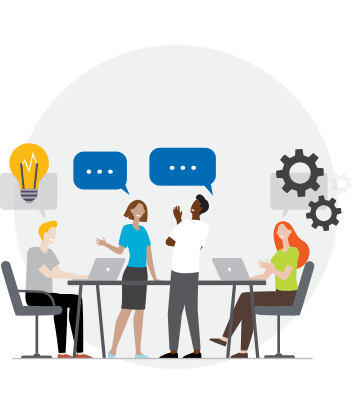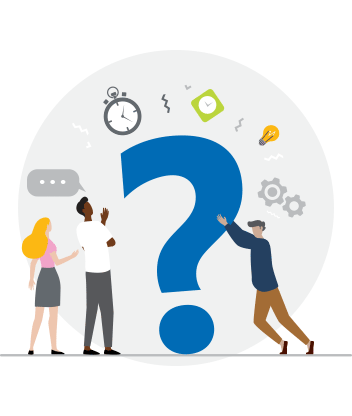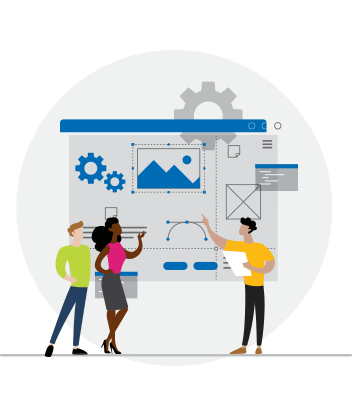 08-24-2021
08-24-2021
The best digital solutions are intuitive and easy to use. Human-centered design (HCD) is widely recognized as essential in guiding solution development that successfully meets user needs. But how do we maximize the power of HCD principles to truly learn from different user groups and action that knowledge to solve problems in ways that delight users and allow them to accomplish their objectives with ease? Questionnaires might be useful for collecting data from large groups, but they lack the depth and flexibility that designers need to fully learn how users think and the steps users may take towards achieving their goals. Focus groups can likewise provide a helpful forum for designers to learn from a set of users, but they can limit the scope of discovery by planning discussion topics too narrowly around initial assumptions.
To complement these approaches with human-centric discovery techniques, the design philosophy at Halfaker, an SAIC company, prioritizes one-on-one interviews as one of our key tools for learning about user goals and expectations. To glean insights from our leading user experience (UX) designers and researchers, we conducted a question-and-answer session with members of our HCD/UX corporate practice area to shed light on the tools and techniques they use to conduct effective user interviews.
What recommendations do you have to prepare for an interview?
Start by identifying your objectives and the information you want to learn, then, build your questions around those goals. Be sure to do research in advance; you want to understand the topic and make sure your questions are about the user’s experience, not about things that you can easily discover on your own. When you prepare for an interview, it’s hard to see your own biases and may be difficult to identify your assumptions. Be flexible with your questions and adapt as you learn from the answers. Encourage your interviewee to think outside the box by asking open-ended questions, such as: “How would you go about this activity if there were no constraint at all?” or “What do you expect to see when?” or “Where have you seen this work better before?” or “What do you need to accomplish by doing this?” Let the user know that nothing is outside the lines in this interview; you’ll receive more valuable feedback if you encourage them to think big and avoid limiting your questions in scope to existing tools, processes, or systems.
Once you have the prep work done, what does a typical interview look like?
In general, you should help your interviewee feel at ease from the outset while remaining focused and professional when you ask them questions. Connecting with people and minimizing disruptions and anxiety encourages open and honest dialog. To facilitate this connection, it’s a best practice to bring a note taker to the session to document the conversation, as it’s impossible to connect with someone if you’re focused on your screen or keyboard. Using open-ended questions is another great way give people space to reveal their perspective, since yes-or-no questions inhibit your ability to uncover new information during the interview. Keep yourself open to learning new perspectives and avoid guiding someone to an expected response. As you get more comfortable with interviewing, you can ask follow-up questions on the fly as unknown information is revealed.
You talked about preparing questions; should designers use scripts for their interviews?
A script can help guide conversations, especially with sensitive topics, but designers should think about a script as a tool that can help you stay on track. You should neither limit the conversation to your prepared script, nor feel compelled to ask every question. Use your judgment to adapt based on the conversation. When you’re conducting a series of interviews, you may find that you need to change your script between interviews. Don’t hesitate to incorporate the feedback you get; adjust your script for subsequent sessions and use it as a jumping-off point for learning and discovery — as opposed to a prescriptive set of items you need to cover.
What advice do you have on how best to close out an interview?
At the end of an interview, you should review next steps and share how you’ll use the information you learned. You want the interviewee to know that you value their time and insight. Following up with a thank-you email is another good practice and helps to remind the person that they can contact you if they have more feedback or other ideas to share. Beyond that, though, remember that interviews are just the first step in the larger design and development process. Whether you set up another formal interview or not, communication with your user base is essential to developing and continuously iterating solutions that truly meet what users need. You want to be open to receiving new insights after the interview ends and continue to iterate and design with users, not for them.
Tell us about one of the most challenging interviews you’ve conducted. What lessons can we take away from that?
On one past project, we needed to evaluate and update documentation and guidelines that are provided to a group of people when they are dealing with the death of a loved one. You can imagine how sensitive a topic that can be, especially because we had to ask interviewees to talk to us in some detail about a particularly sad and difficult part of their lives. That’s obviously a more extreme example, but it’s helpful to recognize that some topics can be hard for participants to discuss and showing empathy and understanding helps overcome those challenges. For this discussion, we relied heavily on a script to help start those difficult conversations. It can be hard to find the right words in the moment, and it was important for us to show empathy, respect, and understanding.
If you were giving advice to someone who is about to conduct their first user interview, what would you recommend?
Be yourself and respect, value, and esteem the user and their opinions. Ask interactive questions, and if something isn’t immediately clear to you, persevere. Don’t be afraid to ask for elaboration, no matter your skill level or experience interacting with users. You can ask something along the lines of, “Can you draw that out for me?” In this way, you keep the conversation productive and accurately capture what they say. It’s your job to learn from the interviewee, and you shouldn’t be afraid to ask follow-up questions to ensure you gain a clear understanding of what they’re sharing with you. During this one-on-one time you want to develop a rapport with the user that will establish the foundation for continued partnership throughout the product development process. Think of it an ongoing, collaborative relationship where your job is to create a safe space in which the user feels comfortable sharing their thoughts and ideas from the outset. This enables you to set the stage for even greater productivity down the road and maximize the value of your collaboration with users in future phases of the product development process.
Ultimately, there’s no substitute for practice: the more interviews you conduct, the better you will be at deriving value from them. That can only come with time. If you’re just starting out, you might want to shadow an experienced researcher to listen or take notes or set up a dry-run session where they can provide you with feedback in a safe environment. With hands-on experience, you’ll be more prepared to pick up on nuances and conduct an effective interview. But remember, an interview is just one touch point of many in HCD-focused development and is complemented by iterative prototyping, demos, feedback gathering, usability testing, and retrospectives. You’ll get the best feedback when your user realizes that their opinions and time are valued as integral pieces of the full design and development process; they are critical to the success of the project throughout its life cycle, not just at the beginning.






